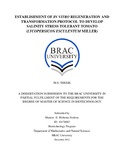Establishment of in vitro regeneration and transformation protocol to develop salinity stress tolerant tomato (Lycopersicon esculentum Miller)

View/
Date
2012-12Publisher
BRAC UniveristyAuthor
Ferdous, Manzur -E- MohsinaMetadata
Show full item recordAbstract
Tomato (Lycopersiconesculentum Miller), a nutritious plant, can be substituted to overcome malnutrition and offers much higher income for the farmers in Bangladesh because of its high demand throughout the year. However, there is a considerable loss
in their production due to environmental stress. Such as, salinity affected one tenth of the total cultivable lands of Bangladesh due to the climate change and sea level rise. It afflicted every aspect of plant physiology and biochemistry thus economic yield. Therefore, a simple and efficient transformation protocol is necessary to develop salt tolerant tomatoes. In the present study, a reproducible and efficient regeneration protocol was obtained as a prerequisite for tomato transformation. Among five varieties tested in this study, BARI Tomato 15 and BARI Tomato 2 showed equally best regeneration response (96%). Highest shoot number was obtained in MS+2 mg/l BAP. BARI Tomato 14, BARI Tomato 15 and BINA tomato 3 showed highest rooting response (100%). Maximum number of shoot was observed while explants
placed in the regeneration media at 1.5 cm distances apart for tested varieties namely, BARI Tomato 3 and BARI Tomato 15. Seeds were collected from ripen fruits of regenerated plants and their viability was tested. These tissue cultured plants were found as same as naturally grown plants. In Agrobacterium-mediated transformation, these five tomato varieties were transformed with pBI121 (containing nptII selectable marker gene and uidA gene) for optimization of various factors. Co-cultivation of explants with a bacterial concentration of OD600 0.68 for two days resulted in the highest transformation frequency of 47% in BARI Tomato 3. Then transformation was performed using these proper conditions with Agrobacterium strain containing pH7WG2_OsNHX1_1.6 (OsNHX1antiporter gene, cloned from rice) to make salinity tolerant tomato plants. In this case, highest transformation frequency of 20.5% was obtained by BARI Tomato 3. Transformation of putative transformed shoots was confirmed by β-glucuronidase (GUS) assay and PCR. The optimized transformation procedure is simple, efficient and does not require any feeder layer or acetosyringone.
